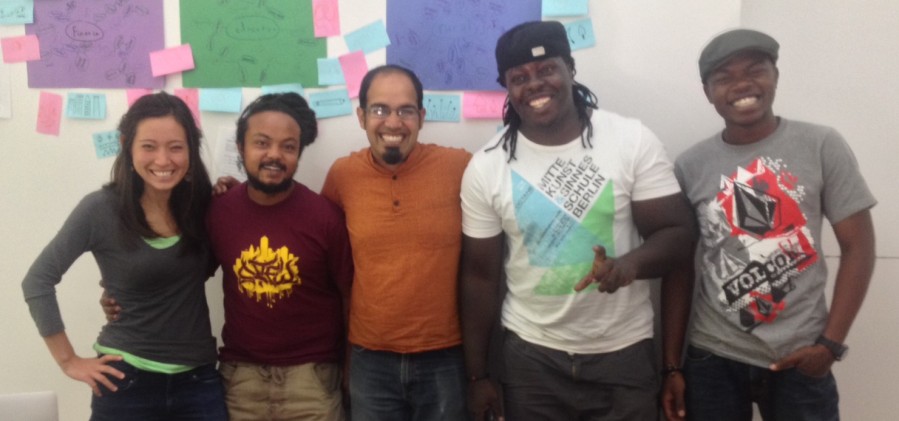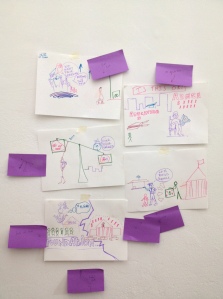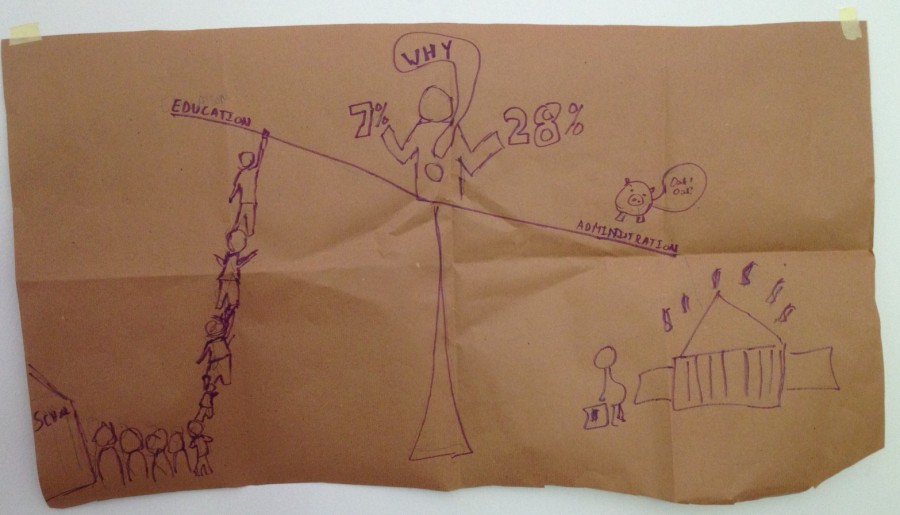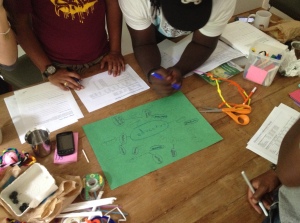We were recently awarded a Making All Voices Count grant with our friends at the Mtaani Initiative and Radar, focused on creative communication in Nairobi’s slums – we’re calling the initiative Sauti Ya Mtaa.
I strongly believe that data-driven advocacy is a great way to bring about change. However, you have to find the right story to tell and the technique to tell it. We’ve trying murals as a new way to tell data-driven stories, but none of our pilot projects worked with professional artists. Street artists know the context and messages that will work in their community. That’s why we’re so excited to have kicked off our collaboration with graffiti artists in Nairobi! Over the next year we’re going to work together to develop local capacity to do innovative creative messaging to catalyze change in their communities. Sasha, Uhuru, Me, BankSlave and Swift9 met up in Berlin for 2 days for our first training (before the OKFest started). Our goals included:
Sasha, Uhuru, Me, BankSlave and Swift9 met up in Berlin for 2 days for our first training (before the OKFest started). Our goals included:
- me learning how they work
- them learning some of our facilitation techniques
- designing a data mural to paint in Nairobi
- planning the next steps in Nairobi
Training
We had a packed agenda over the two days! We started off getting to know each other a little bit, and exploring some inspirational examples, including our data murals. http://www.pinterest.com/rahulbot/street-art-data-murals/ We kicked off our building exercises by running the data sculptures activity. The artists liked the materials involved and thought people would respond to how playful it was. Next I introduced our story types and some data on education and employment from the Nairobi budget and SID report for Nairobi County (1). We all looked for stories of different types. The artists found the story type templates helpful, but struggled with the idea of saying something in the data was either a “factoid”, a “comparison” or something else. This raised the great point of how we can get lost in the activities sometimes, stuck on trying to do them “correctly”, when in fact it didn’t matter exactly which type of story it was. One artists said:
filling in a factoid story form appeared challenging at first but eventually after a while it proved to be a vital part in this whole process
Once we had a number of stories, we pulled some abstract ideas from them – “education”, “finance” and “rural”. We did some word webs for these words together, to try and concretize them. We put these on the wall, grabbed stickies, and drew any of the words that could be drawn.
The artists loved this activity, and immediately thought of ways it could be relevant for their workshops. This process of coming up with symbols to represent abstract ideas fits well into past work in Nairobi (see the Vulture murals, for instance). One artist said:
this approach is fun and should be used all the time
With these words and the data stories in mind, we took some time to focus on visual narrative. First we created storybooks to tell the data stories. The artists spent a little more time than I had hoped writing out their stories – I introduced it poorly and they had great feedback for how to present it as a comic book next time I try it:
Story Boooks are fun, but we could make it more interactive as a comic book set up rather than what I did (more writing and less illustrations)
 To wrap up the design exercises did a pass around drawing for one story they liked most – about the relatively low percentage of budget funding going towards education. One artists said:
To wrap up the design exercises did a pass around drawing for one story they liked most – about the relatively low percentage of budget funding going towards education. One artists said:
the pass around drawing was fun and creative teamwork and saving on time to come up with a concrete concept which usually consumes more time
Another said:
it was fun and got everyone to participate
This led to a small set of drawings that all told the same story. I facilitated a discussion about what elements of the design they liked most, and exercised a little editorial control to generate a sketch of a mural to paint!
I facilitated a discussion about what elements of the design they liked most, and exercised a little editorial control to generate a sketch of a mural to paint! After all this we took a step back and discussed work the artists have done, and issues they cared about. This led to a good conversation about how all the activities felt, how the might fit into work the context in Nairobi. One artists said:
After all this we took a step back and discussed work the artists have done, and issues they cared about. This led to a good conversation about how all the activities felt, how the might fit into work the context in Nairobi. One artists said:
What really got my attention was the structure and approach in general as a session
Next Steps
To close out the packed schedule, we squeezed in a discussion of next steps on the grant. We plan to continue to converse via WhatsApp, and to set up monthly Skype checkins. These channels for communication will feed activities over the next few months.
Notes:
(1) We used the Nairobi Full Budget FY 2013-2014 (online at the International Budget Partnership) and the 2009 SID report for Nairobi County.



You must be logged in to post a comment.